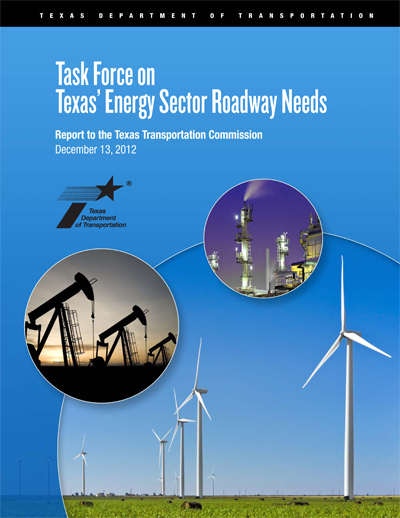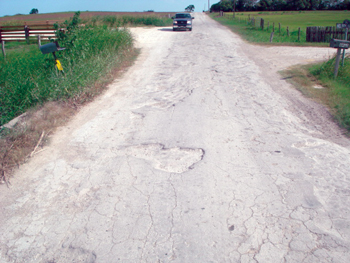 The Task Force on Texas’ Energy Sector Roadway Needs released its final report to the Texas Transportation Commission on Dec. 13, 2012.
The Task Force on Texas’ Energy Sector Roadway Needs released its final report to the Texas Transportation Commission on Dec. 13, 2012.
Several county representatives served on the state-formed task force, including Midland County Commissioner Robin Donnelly, Andrews County Judge Richard Dolgener, DeWitt County Judge Daryl Fowler, Johnson County Judge Roger Harmon, and Zavala County Judge Joe Luna.
Below please find an excerpt from the report, which may be viewed in full at http://ftp.dot.state.tx.us/pub/txdot-info/energy/final_report.pdf.
FINANCE SUBCOMMITTEE REPORT
One of the major challenges in addressing the impact from energy development on roadways is financing for both reactive and proactive maintenance. Large volumes of legally loaded heavy trucks and permitted and un-permitted overweight vehicles damage bridges and reduce pavement life. Pavements are designed to carry the amount of traffic expected to travel that roadway over a specific period of time, usually 20 years, without significant deterioration or damage. Larger-than-expected volumes of heavy truck traffic consume the “life” of the pavement in much less time than expected under the original pavement design.
Research and experience have shown that taking proactive approaches to addressing roadway impacts is a much more cost-effective approach to maintaining the infrastructure and reducing overall repair and maintenance costs by approximately 700 percent. Proactive maintenance strategies include reconstructing or resurfacing a road to preserve it before damage occurs. This could be referred to as “armoring” the road to prepare for high-volume, heavy truck traffic. Conversely, a reactive strategy refers to maintaining or repairing the road after damage has occurred. Regardless of the approach, the cost to maintain a safe, efficient transportation system in high development areas across the state is in the hundreds of millions of dollars. For this reason, financing this maintenance and construction is key to addressing energy sector roadway needs.
The Finance Subcommittee’s task was to originate, collect, and examine new and existing financing methods for use on affected roadways. Please note that the following concepts were put forth by members of the Task Force solely for discussion. Neither the Task Force, TxDOT nor any other state agency is endorsing or recommending any concept listed as follows.
Road Use Maintenance Agreement (RUMA)
RUMA is a method of financing the maintenance of roadways utilized by industry in the drilling of a well. It is an agreement between the state and the company drilling the well.
Under a RUMA, the state and company survey the condition of the roadway to be utilized in the drilling of a well before operations begin. The state and company take a second survey of the roadway after drilling is complete and assess the cost to the developing company of returning the road to its previous condition.
If more than one company utilizes a stretch or roadway, the assessment is shared accordingly; county governments could participate in the RUMA system with state oversight.
Counties are limited to an 8 percent increase in property tax rates without a rollback election to approve the increase. In computing the effective tax rate, new improvements to property are excluded from the tax base so as to not force the effective rate down.
Currently, new mineral wells are not included in the definition of “new improvements” despite adding significant value to the tax base.
If the Tax Code considered new wells as “new improvements,” the effective tax rate would remain roughly the same and would generate significant additional tax revenues. Counties could apply these funds toward transportation maintenance. This would require legislative action.
Commercial Driver’s
License Fee
Increase the fee for receiving Commercial Driver Licenses (CDL) in Texas. This would require legislative action.
Texas has issued 845,543 active CDLs. Each CDL costs $61 for five years, which generates about $10.7 million a year.
Texas issues or renews approximately 170,000 CDLs annually. This means that for every $6 increase in the CDL fee, $1 million in revenue is generated.
Oversize/Overweight Violations
Increase the fines levied on violators of oversize/overweight (OS/OW) permits. This would require legislative action.
OS/OW violators are currently subject to Class C misdemeanors with maximum fines of $500. Tickets written by Texas Department of Public Safety are referred to courts in those counties, which may choose a lesser fine. Repeat violators may be referred to Texas Department of Motor Vehicles (TxDMV) for administrative penalties.
Increased fines could act as a greater deterrent for OS/OW violators, which would curb the impact made by overweight loads. Additional revenue from increased fines could be shared between the state and the county where the citation is issued.
Truck Fee
Establish a weight and utilization fee for trucks. The fee would be proportional in that those that weigh the most and travel the system the most would pay the most. This would require legislative action.
This concept is examined in-depth in the Rider 36 OS/OW Permit Fee Study.
Severance Tax Bonding
Authorize a series of bonds backed by future severance tax revenue. The bond proceeds could be used to upgrade the highway system in affected areas to better handle the volume and weight of truck traffic associated with these activities. This would require legislative action.
Severance Tax Dedication
Dedicate severance taxes from royalties to their counties of origin. This would increase revenue to county systems, but not the state highway system. This would require legislative action.
Dedicated Severance
Tax Growth
Dedicate any increase in severance taxes after an established date to fund roadway improvements in affected areas. This would require legislative action.
Since much of the increase in severance tax revenue can be attributed to the growth of energy development, this dedication would allow much of the money to return to the regions in which it originated.
Public–Private Partnership
With a change in statute, either TxDOT or a county could enter into a public-private partnership to maintain the highway system in an area.
The private entity would collect user fees from commercial traffic. Fees could vary based on weight and distance travelled on system roads to better align with impacts on the system. Usage could be measured by a number of tools including GPS monitors or electronic tags.
County Road Districts
Counties currently have the authority to create road districts under Chapter 257 of the Transportation Code. This allows an opportunity for a new property tax to be levied to be used exclusively on roads.
These districts could exclude current residents from this new tax, only taxing commercial and new residents’ properties. Bonds and revenues generated by these districts would not be included in the truth-in-taxation formulas.
Tire Tax
Authorize the creation of an excise tax on oversized tires, similar to the existing federal tax. This would require legislative action.
This would have the effect of raising revenue from those that may have a disproportionate impact on the system given their larger loads.
TIRZ/TIF
Local governments could consider establishing a Tax Increment Reinvestment Zone (TIRZ) to implement Tax Increment Financing (TIF). This could allow a local government to dedicate or bond off the increase in severance taxes collected after a TIRZ is established.
With this method, an increase in tax revenue from development would be directed to infrastructure in the area collected. This would increase revenue to county systems, but not the state highway system.
County Mineral Rights
Supersede an outstanding Attorney General opinion which held that counties have no mineral rights in land owned by counties or TxDOT. This would require legislative action.
Currently, the General Land Office receives royalty payments for oil and gas extracted from under county right of way. If a change is made, these proceeds could be directed to counties or TxDOT, which could apply the funds to transportation. H
















